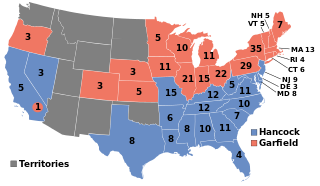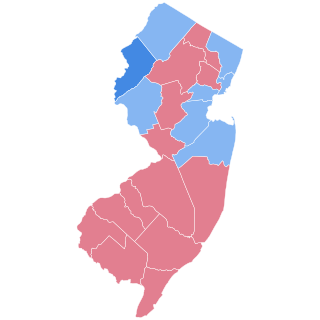
Presidential elections were held in the United States on November 2, 1880. Republican nominee James A. Garfield defeated Winfield Scott Hancock of the Democratic Party. The voter turnout rate was one of the highest in the nation's history. Garfield was assassinated during his first year in office, and he was succeeded by his vice president, Chester A. Arthur.

Samuel Jones Tilden was an American politician who served as the 25th governor of New York and was the Democratic nominee in the disputed 1876 United States presidential election.

Hobart Baldwin Bigelow was an American politician and the 50th Governor of Connecticut.

The 1803 United States Senate election in New York was held on February 1, 1803, by the New York State Legislature to elect a U.S. senator to represent the State of New York in the United States Senate.

The 1880 United States presidential election in New York took place on November 2, 1880. All contemporary 38 states were part of the 1880 United States presidential election. Voters chose 35 electors to the Electoral College, which selected the president and vice president.

The 1880 United States elections occurred during the Third Party System, and elected the members of the 47th United States Congress. Republicans retained the presidency and took control of the House. An unclear partisan situation prevailed in the Senate. As the first presidential election after the end of Reconstruction, this election saw the first occurrence of the Democratic Party sweeping the Southern United States; the party would carry an overwhelming majority of Southern states well into the 20th century.

The 1950 United States Senate election in Vermont took place on November 7, 1950. Incumbent Republican George Aiken ran successfully for re-election to another term in the United States Senate, defeating Democratic challenger James E. Bigelow.

The 1880 United States presidential election in New Hampshire took place on November 2, 1880, as part of the 1880 United States presidential election. Voters chose five representatives, or electors to the Electoral College, who voted for president and vice president.

The 1880 United States presidential election in New Jersey took place on November 2, 1880, as part of the 1880 United States presidential election. Voters chose nine representatives, or electors to the Electoral College, who voted for president and vice president.

After serving one term as U.S. President, Rutherford B. Hayes announced that he would not seek re-election in 1880. Thus, the 1880 election ended up being fought between Republican James A. Garfield, the winner, and Democrat Winfield Scott Hancock.

The 1896 United States presidential election in Louisiana took place on November 3, 1896. All contemporary 45 states were part of the 1896 United States presidential election. State voters chose eight electors to the Electoral College, which selected the president and vice president.

The 1896 United States presidential election in Iowa took place on November 3, 1896. All contemporary 45 states were part of the 1896 United States presidential election. Voters chose 13 electors to the Electoral College, which selected the president and vice president.

The 1880 United States presidential election in Michigan took place on November 2, 1880, as part of the 1880 United States presidential election. Voters chose 11 electors to the Electoral College, which selected the president and vice president.

The 1880 United States presidential election in Iowa took place on November 2, 1880, as part of the 1880 United States presidential election. Voters chose 11 representatives, or electors to the Electoral College, who voted for president and vice president.

The 1880 United States presidential election in Colorado took place on November 2, 1880, as part of the 1880 United States presidential election. Voters chose three representatives, or electors to the Electoral College, who voted for president and vice president.

The 1948 Indiana gubernatorial election was held on November 2, 1948. Democratic nominee Henry F. Schricker defeated Republican nominee Hobart Creighton with 53.56% of the vote.

The 1896 North Carolina gubernatorial election was held on November 3, 1896. Republican nominee Daniel Lindsay Russell defeated Democratic nominee Cyrus B. Watson with 46.52% of the vote. This was the only election in North Carolina between 1872 and 1972 in which the Republican nominee won the governor's office, and the only one until 2016 in which no candidate received over 50% of the vote.

The 1880 United States presidential election in Kentucky took place on November 2, 1880. All contemporary thirty-eight states were part of the 1880 United States presidential election. Kentucky voters chose twelve electors to the Electoral College, which selected the president and vice president.

The 1902 Nebraska gubernatorial election was held on November 4, 1902. Republican nominee John H. Mickey defeated Democratic and Populist fusion nominee William Henry Thompson with 49.69% of the vote.
The Boston mayoral election of 1853–1854 saw the election of Citizens Union Party nominee Jerome V. C. Smith. The election took three votes, as no candidate secured the needed majority in the first two attempts. Incumbent Whig mayor Benjamin Seaver had run for reelection as his party's nominee in the first vote, but opted not to compete in the second or third votes.





















